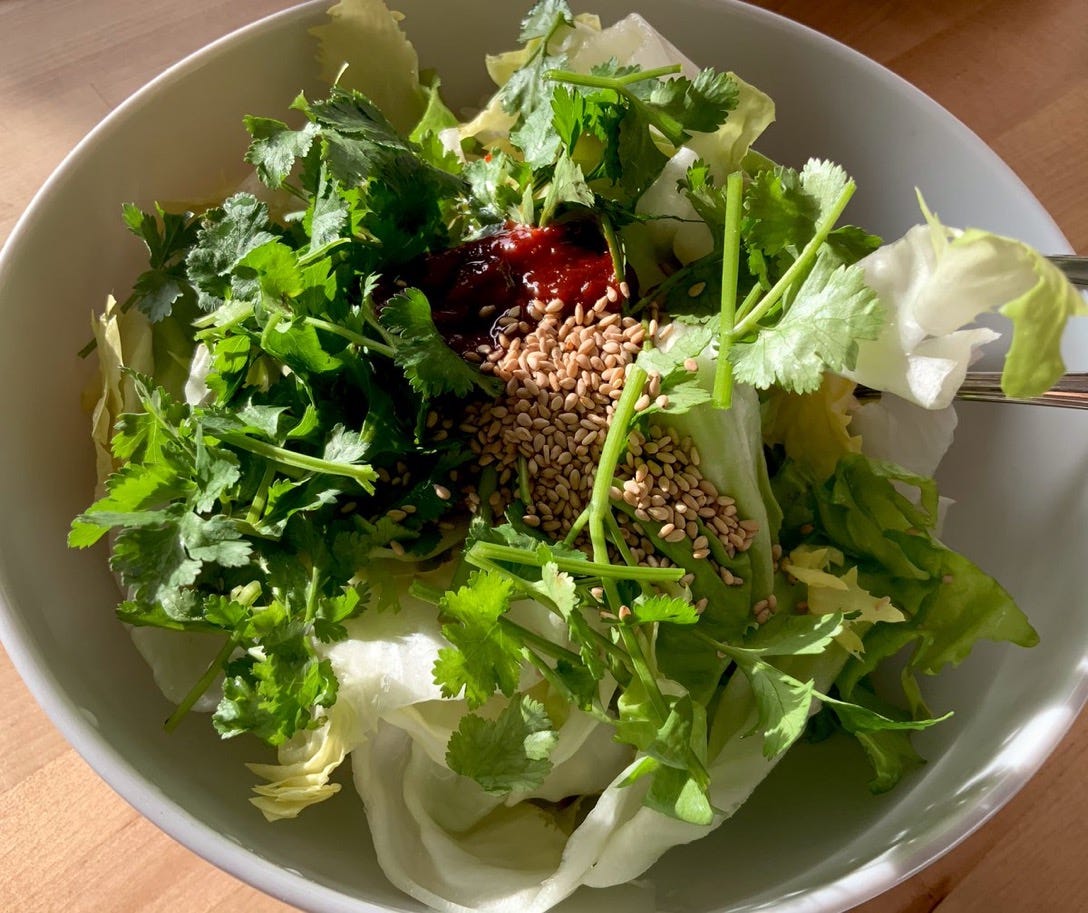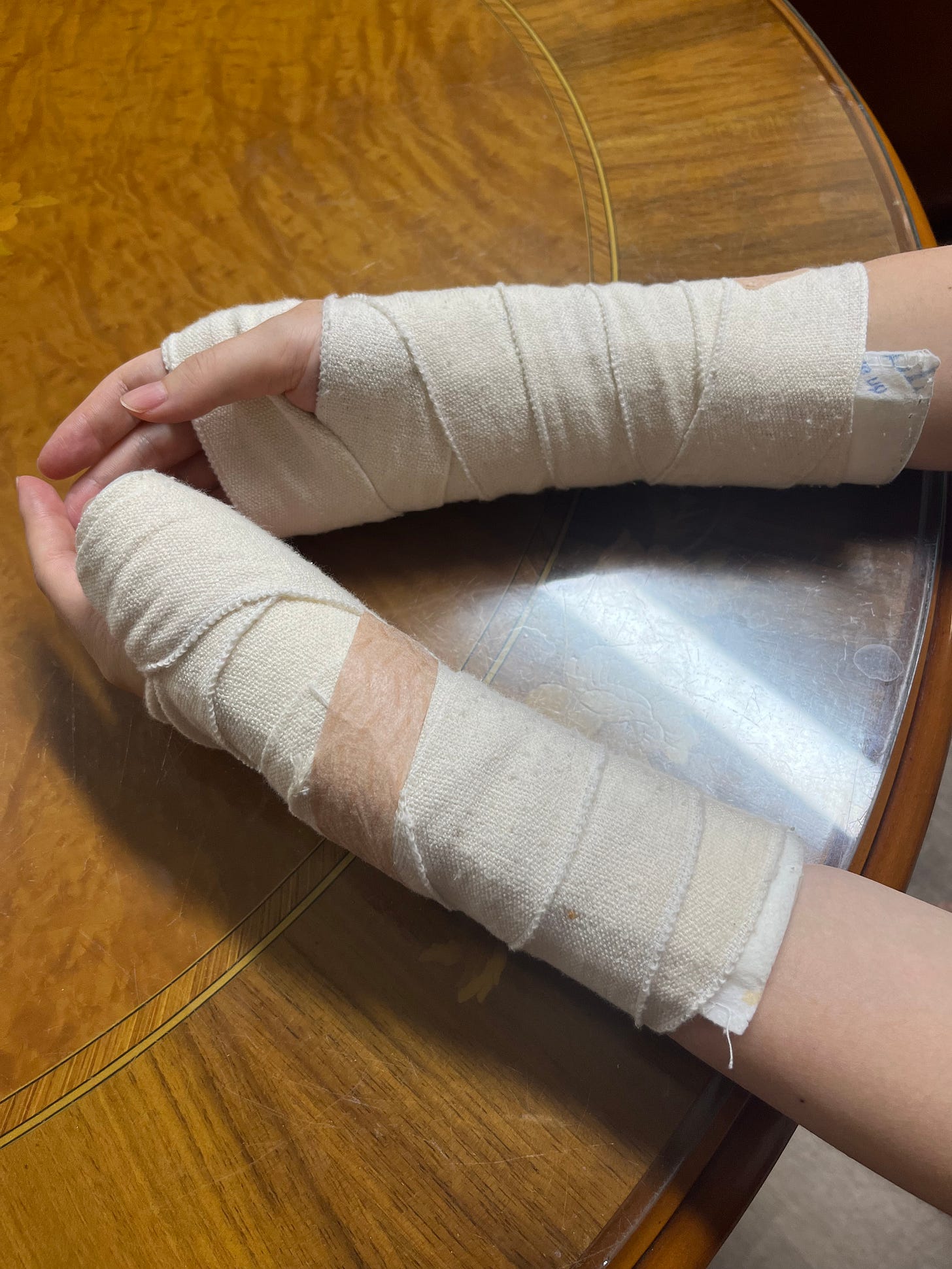안녕, it’s Ari, your talkative Korean friend and weekend reminder. 🎉 Today’s newsletter is about a summer-friendly bibimbap and the cost of seeing a doctor in my country. No Korean lesson today but there’s a surprise announcement at the end. Let’s dive in!
Monks’ Favorite Bibimbap

When you don’t want to use the stove to prepare food as the weather gets warmer these days, Cilantro Bibimbap can be a great choice. This dish is a popular temple recipe loved by monks in South Korea. The ingredients are super simple: just cooked rice, cilantro, and sauce. I found the recipe on a monk’s YouTube channel, and it’s completely vegetarian. However, it does take a little effort to make the sauce. If you want a simpler recipe, you can just add some gochujang, sesame seeds, and sesame oil instead of the sauce. The full recipe is below.
For 1 serving:
1. Cook rice. (If you don’t have an electric rice cooker, you might have to use the stove 🙏)
2. Chop a handful of cilantro.
3. Make the sauce by mixing 1 tablespoon of soy sauce, 1 tablespoon of water, 1/3 tablespoon of sugar, 1/2 tablespoon of chili powder, 1 tablespoon of sesame seeds, 1 tablespoon of sesame oil, and 1 tablespoon of vinegar or lemon juice.
4. Combine the rice, cilantro, and sauce in a bowl. You can add other green veggies if you want.
Enjoy this refreshing and healthy dish perfect for a hot summer day! 😋
My Experience with Healthcare in South Korea
I have gone to see a doctor more in the past year than in my entire life, which makes me well-qualified 🫠 to talk about healthcare in my country. The following is the story of my experiences, along with those of my friend and family, ranging from mild illnesses to serious conditions. All costs are in USD for easy understanding.
COVID
COVID rapid test: 15 USD
One visit to a doctor including a shot and 5 days of medicine: about 10 USD
I recently developed symptoms like a sore throat and tiredness after spending time with a friend who had COVID. I went to see a doctor and mentioned my contact with a COVID patient. She informed me that there are many COVID patients right now and that I likely had it too. However, she didn’t recommend taking the test which costs about 15 USD, because whether it was confirmed positive or not, the treatment and medication would be the same. So, I didn’t take the test. Instead, I received a shot to reduce the coughing that bothered me at night and was prescribed medicine. It took two visits to the doctor to finally get better, though I still cough a little from time to time.
During the pandemic, all hospital bills related to the virus were free, including the test, shot, medication, and even hospitalization. During this time, a friend of mine had a severe case of COVID. She had trouble breathing and ended up being hospitalized. She spent an entire month in the hospital, including two weeks in the intensive care unit on a respirator. When she was discharged, she learned that her hospital bill, amounting to about 10,000 USD, was fully covered. She only had to pay for her post-care medication, which cost about seven USD. She often says she was very lucky to get COVID during the pandemic instead of now.
Now that COVID treatment is no longer free, it’s still affordable. One visit to a doctor, including a shot and 5 days of medicine, is about 10 USD, unless the symptoms are serious. This cost is similar for many other mild diseases like colds and enteritis, although it can vary depending on the number of pills or shots you take.
Cervical Disc Herniation
MRI test: 320 USD
One visit to a doctor including physical therapy and 5 days of medicine: 12 USD
I experienced hand pain that started about a year ago. It took many visits to doctors and switching hospitals to finally learn that I had cervical disc herniation. To get diagnosed, I had to undergo an MRI test, which cost about 320 USD. The cost of an MRI used to be cheaper, less than 100 USD, but the government lifted the coverage last year. Now it costs between 300 and 600 USD, depending on the hospital and machine.
My MRI cost about 320 USD, but luckily I didn’t have to pay the full amount because I have private health insurance, which covered around one-third of the test cost. Although all South Koreans have universal healthcare, which costs about 100 USD a month on average, the majority also have private health insurance. This is because national healthcare doesn’t cover all bills, including some tests and treatments, so many Koreans prepare for the worst with private health insurance. Any Korean can get this insurance via insurance companies, whether they’re employed or not. The insurance fee can vary depending on age and coverage, usually costing between thirty and seventy USD a month.
Cancer
Rehabilitation hospitalization for a month: 3,200 USD
Private health insurance can be very helpful, especially for cancer patients. Many cancer patients who recover after surgery often go to rehabilitation hospitals. These hospitals are not covered by universal healthcare and therefore very expensive, costing around 3,000 to 4,000 USD a month, which is much more than the average monthly salary of a Korean worker, about 1,900 USD. The insurance usually covers 90% of the hospital bill for six months or so. This insurance was very helpful when my mom had surgery and stayed in the hospital in the past. She is very healthy now 💪.
Conclusion
You might think my country has a relatively good healthcare system. I used to think so too, but unfortunately, this is changing dramatically. The nationwide strike of doctors and medical school students against the government’s plan to increase medical school enrollment has been ongoing for over 4 months, with no end in sight. Experts warn that this medical crisis will take a huge toll on the country’s healthcare for over 10 years. Additionally, the government is moving towards a private healthcare system similar to that in the United States, decreasing universal healthcare coverage and providing people’s health data to private companies. These changes are raising concerns about the future affordability and accessibility of healthcare in South Korea.
Before wrapping up, I want to share that I just started working on a Korean grammar workbook for beginners. 👩🏻🏫 I’m planning to release it before summer vacation. Please look forward to it!
As always, thanks for reading! If you liked my newsletter, ☕️ buy me a coffee ☕️ to support my work. It’ll help me keep writing! I will be back next week. 안녕!





Hello Ari, I have missed very much your Friday sends for a while. Hope you are better or getting well.
Some important and interesting conversation and food.
Monk's Bibimbap looks v good. And link to the monk's site is nice.
Your next story is more complex but something I know quite a lot about.
COVID acute testing is free here in Oz as is treatment and if you are seriously ill and and admitted to a Public Hospital. Covered under Universal Health Care Act.
It is far from perfect system, but certainly allows for acute health situations. There is a No Refusal of Acute Care for anyone even if if not citizens.
Your own treatment. Did you have an EMG? And seriously don't go for neurosurgery ever.
Your splints seemed to have failed, as not keeping position in slight extension.
Your post on post On Ca Recovery if need s to be in hospital or else where and not covered by Primary Health Care at all.
A movement to a US Private Model of care type of system will only lead to more money for US/SK companies to some degree, but to worse care for uninsured and less certain for the insured even
And bad health outcomes n long term.And in many cases more extremely costly but with less good outcome.
Look at Aus /NZ,Canada,Scandiplaces, UK, for better examples.
Glad you are back. Cristoffa.
.
Hi Ari... new here!
I lived in Korea for over 12 years and go back to visit my inlaws often. Although I think the current state of Korean healthcare with regards to the doctors strike is terrible (and I find myself not able to support really either the doctors themselves, or the government) I think that overall Korea has an excellent system for healthcare for those who can afford to also supplement it with private insurance. I am currently in the UK, and although all healthcare is free at the point of delivery, the problem with this is that the public health system is so clogged up with people that waiting times are insane unless you are at risk of immediately passing away. This is because people take free healthcare for granted, and even if they could afford to use a private hospital, they will say it is their right to get the free public care, and so overburden the public system. I feel like the Korean system encourages more private practice at a reasonable fee for less serious and non-urgent health issues.
The big problem with the Korean system, as you point out, is when you have a more serious issue that needs a big intervention or long term care... I feel like if Korea could pivot to a system of 100% coverage for serious conditions, and perhaps a system of 15-25% public health coverage for minor conditions, you might end up with the best of both worlds?
좋은 하루 보내세요!